Combat aircraft. Long Arrow: Dornier Do.335
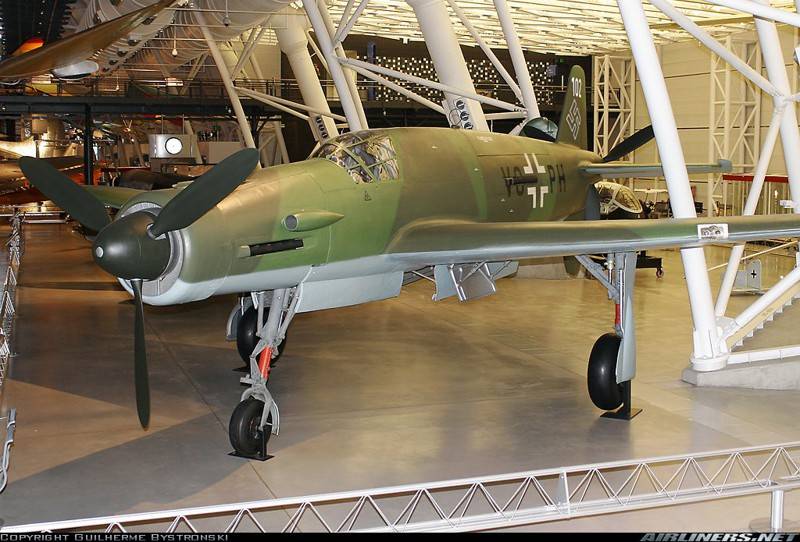
It was one of the fastest piston fighters in history. aviation at all. If the Germans could defeat the technical problems, which generously rained on the 335th all the time, and still organize its serial production, then ...
Yes, history does not know the subjunctive mood. But the Mustangs and Thunderbolts, not to mention the Tempest and Spitfire, would have been difficult, because the German pilots would have a fighter in their hands, capable of effectively fighting any Allied aircraft. And possessing remarkable technical characteristics.
But let's start (the phrase becomes classic) with history.
But not with the history of the plane, but with the idea. With the idea of tandem engines.
If someone believes that Do.335 was so outstanding and original in terms of design, I will disappoint. The scheme was rare, but not something so out of the ordinary. They used it back in the First World War. In German aviation, there were Fokker KI, Fokker M-9 and Siemens-Schuckert DDr.I airplanes designed specifically for this scheme.
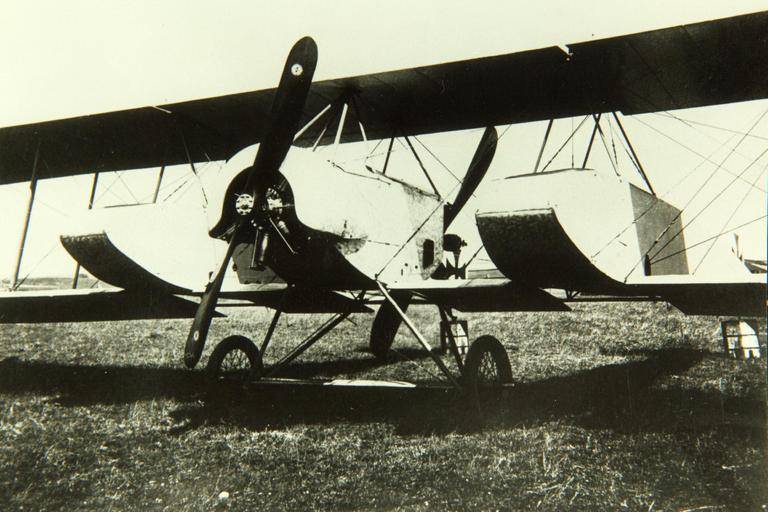
And since German planes fell into different hands, it is no wonder that after the war this scheme received little, but recognition.
At least in the USSR, extremely interesting machines were created with the tandem arrangement of the ANT-23 (I-12) and SAM-13 engines, and such machines were built in Europe.
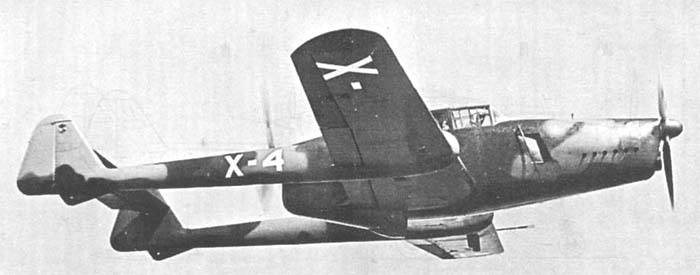
For the most part, all the cars had a similar design: in the short gondola fuselage there were front and rear engines, between which was the cockpit. The front engine rotated the pulling screw, and the rear engine pushed. Since the rear of the fuselage was occupied by a motor, the aircraft were equipped with a double-beam tail.
The French developments were an exception, but at Arsenals both engines set in motion two coaxial screws rotating towards each other.
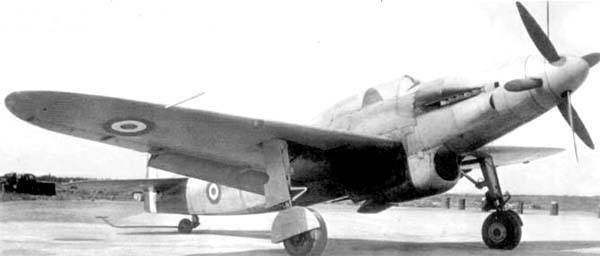
But as work on aircraft in all countries required to lengthen the fuselage. The tiny cockpit, sandwiched between two engines, is a thing of the past. But then this happened: if the fuselage was extended, the torque from the rear engine would have to be transmitted to the screw through a long shaft, which inevitably led to strong vibrations. Plus, the propeller behind the wheels adversely affected the handling of the aircraft.
The two-beam scheme allowed to maintain the effectiveness of the rudders, but led to the fact that the aerodynamic resistance of the machine increased.
But the designers fought with vibration for quite some time. Still, the long shaft has become a huge problem. In general, in my opinion, for all the time of piston aviation, only a few aircraft projects have been obtained where the problem of a long shaft was solved in general. But in fact: the hero of our story, the flying boat Do.18 and the American P-39 and P-63, “Aero Cobra” and “Kingcobra”.
Well, yes, the P-39 and P-63 were aircraft with a classic propeller arrangement, but there was a long shaft.
So it turned out that the “push-and-push” scheme was not implemented humanly, but it excited the design brains for a long time. No wonder, such a scheme was beneficial. After all, the aircraft had a classic silhouette with a wing without engine nacelles, but had the power of a twin-engine aircraft with all the attendant type of increased survivability and carrying capacity.
Indeed, even in the event of a failure or damage to one engine, it was possible to continue flying on a second engine. Moreover, the “push-push” was not threatened by such an unpleasant moment of a twin-engine aircraft as a skew thrust. That is, many twin-engine engines could fly on one engine, but who said that it was easy and convenient?
With a tandem arrangement of engines, such a skew could not occur in principle, it is clear that the thrust vectors of both engines coincided. There was even the possibility of an economical flight with only one engine turned on. In addition, another engine behind the pilot’s back is protection. In fact - armor that is not ballast.
Claudius Dornier understood all this a long time ago.
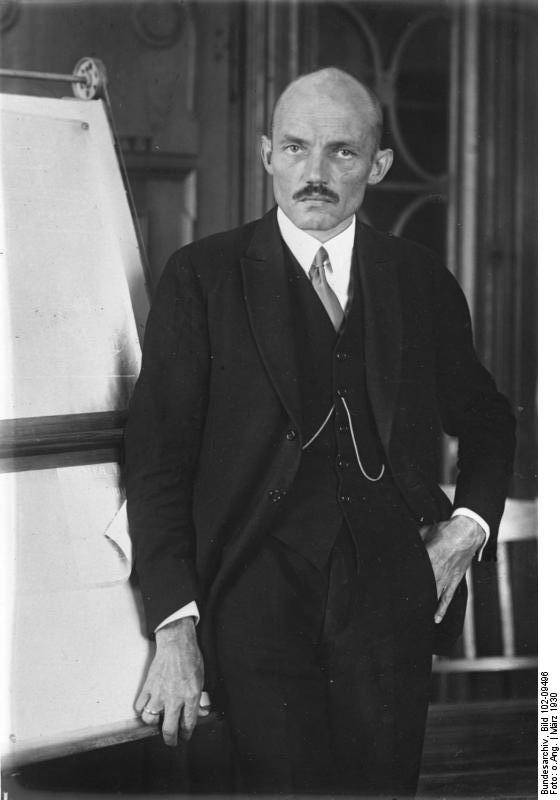
In fact, Dornier preferred to build flying boats. The first of his flying boats was the Rs.I (Riesenflugboot I). This aircraft went down in history as the first German aircraft to use duralumin in its construction. The aircraft was completed in October 1915 and began testing, but drowned in a storm in one of the first flights.
But the second plane, the three-engine Rs.IIa, survived its alteration into a four-engine ... tandem scheme! Dornier arranged the engines in pairs in two engine nacelles, with the front engine rotating the pulling screw and the rear engine rotating the pushing one. From that moment on, this arrangement of engines became another Dornier brand name.
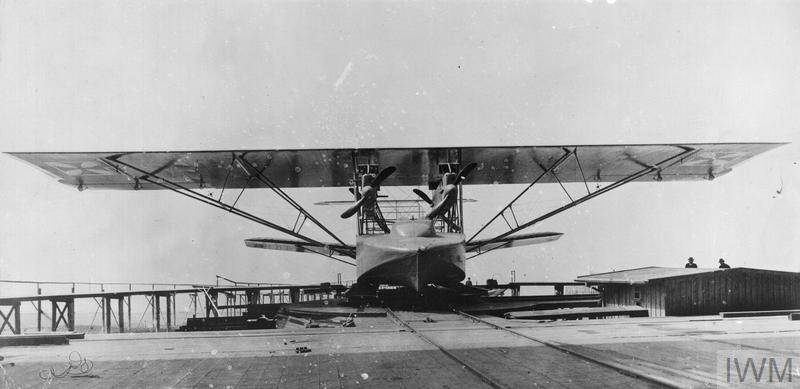
Dornier built his planes anywhere, but not in Germany, bound by the Treaty of Versailles. For example, in Italy, at the specially organized company CMASA.
The main objective of the company was to develop aircraft that are subject to the limitations of the Treaty of Versailles and therefore prohibited in Germany. And the first such machine was a boat that made Dornier a world-famous company.
It was the Do.J “Wal” flying boat, which was soon licensed in Japan, Holland and Spain. The boat was recognized as one of the best cars of the time, it was bought by many countries, including the USSR.
Presumably, no one will be surprised that the boat was designed in tandem ...
In addition to civilian vehicles, Dornier also designed military aircraft in Italy, including Do.N Falke and Falke-See fighters. The second, as the name implies, was a float seaplane. And it was released even in the USA under the name Curtiss-Wright WP-1.
The name thundered, Dornier became a famous designer, and projects rained down one after another.
Another interesting design was tested in the Do.14 flying boat. Two in-line BMW VI engines were placed side by side in the fuselage. The engines rotated one (but large, diameter 5 meters) screw through the gearbox. The screw was pushing. According to this scheme, on the racks above the fuselage it was possible to place a pulling screw, but Dornier had a love for pushing screws.
The already mentioned Do.18, has become a kind of quintessential innovation.
He also had engines in tandem, but the rear engines just had elongated shafts connected to the pushing screws. I must admit that Dornier managed to eliminate the inevitable vibration in such cases. And in the Do-26 model, the designer went even further. Experiments with shafts made it possible to implement a system for deflecting propellers upwards during takeoff so that the propeller blades did not hit the water. The secret was simple on the one hand - a long shaft with joints, but only Dornier could realize this.
With such a baggage of development, it’s no wonder that Dornier decided for more and during the 1937 year developed four projects, one cooler than the other. After thoughtful reflection, one, the so-called P.59-04, was left and even registered a patent for it.
According to the patent, it was an aircraft consisting of three parts: the front one with the engine and the pulling screw, the central one with the cockpit and other stuffing and the rear, in which the second engine was located, pushing the screw and tail.
The central part was separated from the rest by fire walls. Plus, there was a reservation of all parts with sheets a few millimeters thick.
The aircraft was to be equipped with DB601 engines with 1250 horsepower. and develop an estimated maximum speed of 755 km / h at an altitude of 5000 m.
In general, the aircraft was originally planned as a high-speed bomber. The machine was drawn very remarkable both technically and externally. If everything was clear with the engines, a tandem scheme with a shaft on the rear screw drive, then in other moments there were interesting innovations.
The tail has a cruciform pattern to protect the rear propeller from impacts on the ground. The second feature of the aircraft was the wings of variable sweep, adjustable within 20 degrees on the ground.
After completing the preliminary work, Dornier began to offer his brainchild to the Luftwaffe, but then he was waiting for a cruel refusal. The fact is that at the time the work was finished in 1940, the Luftwaffe command was in a kind of euphoria and seriously believed that aircraft that were already in service would be enough to solve any problems.
How it all ended after five years, we all know, as well as how difficult it was to break through the existing system in Germany with a new plane. Goering categorically did not want to consider long-term programs, with the possible exception of developments in jet aircraft. But even there the “most equal” was Willy Messerschmitt, and Ernst Heinkel and Heinrich Lubbe (Arado) were, as it were, less equal.
But Dornier did not give up and continued to work on the plane. Apparently, he felt that a plane would be needed. You can call it a design prediction of the situation, but it all turned out that way.
Dornier even cheated and developed a hybrid. In front was a DB603 piston engine and a jet engine in the rear. The nozzle was placed under the tail, which ceased to be cruciform.
The efforts were really rewarded. Especially after the 1942 of the year, when everything went wrong on the fronts for the Germans, and crowds of British and American bombers began to appear regularly over German cities.
Especially got "Mosquito", with which the Germans really could not do anything at first. Lightweight, wooden, with two good engines, the Mossi looked equally good both in the role of a fighter and a bomber. But we already talked about wooden hemorrhoids for the Luftwaffe.
In general, something had to be done with the Mosquito problem. That is, to come up with some method of counteracting the light and fast (and poorly taken radars of the time) British aircraft.
Competitive conditions were sent by Arado, Junkers and Dornier. And it is not surprising that Dornier won as a more ready and high-quality aircraft. At Arado, the Ar.E-561 project frankly did not work out. Work on it began already in the 1938 year, because the aircraft was very similar to the Bf-110 and was not much more than it.
At Junkers, on the contrary, the design was very innovative, but not brought to mind. And Ju.EF-115.0 did not go further, although it was a very advanced aircraft. He had two in-line engines located in the fuselage in front of and behind the cockpit in accordance with the tandem scheme. Both engines rotated two coaxial three-blade propellers. But there were so many flaws that it became clear that there was only one winner. Dornier.
But it was not there. The plane did not go into series. More precisely, he was stubbornly not allowed. There was an evil genius named Willy Messerschmitt. We already concluded at the time that Mr. Messerschmitt for some reason decided that everything flying in the Luftwaffe should have been made at his plants. And if Messerschmitt was forced to endure Kurt Tank and his Focke-Wulf, then Dornier was clearly the third superfluous according to Willy.
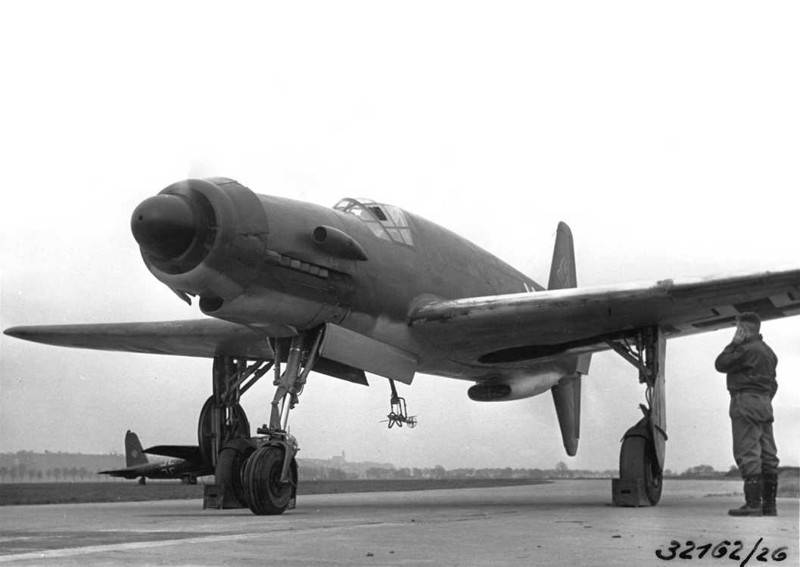
But Messerschmitt was very dangerous, and most importantly - a poorly predictable player. But he also made a request, although no one called him particularly. And in the 1942 year he presented the project Bf.109Z. Zwilling, that is, a pair of two standard Bf.109. And he even began to actively push the plane towards the series, building a prototype, but it (the prototype), fortunately for everyone, was destroyed during the bombing.
But Messerschmitt continued his work and even presented another project in 1943, with which a scandal erupted, since it was a complete copy of the Dornier R.231 project.
Dornier, whom all these intrigues brought to a white heat, turned to the Inspector General of the Luftwaffe, Field Marshal Milch. Milch seems to have ordered that he stop playing covert games and build a plane, which by that time was already called Do-335.
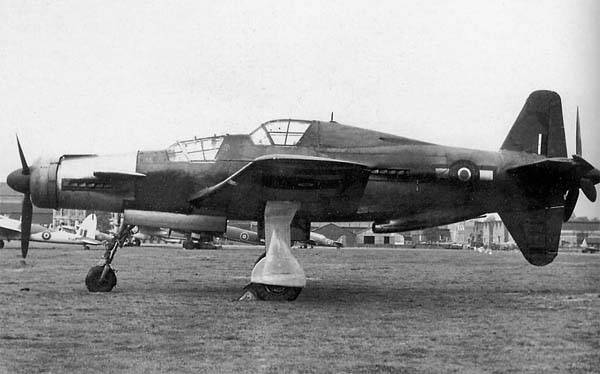
However, the contract was limited to only 12 units, and in all it was supposed to release a series of 35 aircraft in the version of a high-speed bomber. Then. And in the end, the work went so-so, neither shaky, nor roll.
But Dornier was very lucky. Quite suddenly, Do-335 received the support of a very serious person. Adolf Hitler himself became interested in the machine.
It’s not worth repeating that the Führer was a bit off on all sorts of unusual samples, and everything that at least looked a bit like “miraculousweapon", Aroused his interest and support. So it happened with Do-335.
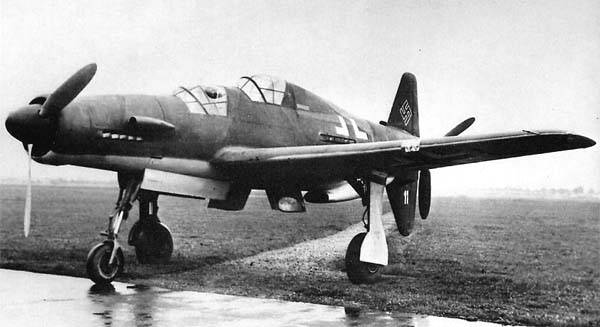
But Hitler in 1943 is not Hitler in 1945, therefore his interest in Do-335 was quite objective. Moreover, he was completely obsessed with the idea of the Blitzbomber. Yes, then his obsession will play a bad joke with Me.262, but he was still, by design, a fighter, and Dornier turned out to be a bomber.
When the threat of the Allied landings in France began to take on a distinct outline, Hitler categorically demanded to expedite the work on the “Shnellbomber”.
By that time, it became clear that the experiments with Me.262 ended in nothing, and that a fighter could not be turned into a bomber under any circumstances. Yes, Me.262 had three advantages: high speed, high carrying capacity and the ability to act as a fighter. It is difficult to say how much the alteration into a bomber complicated the whole thing with Me.262, it seems to me that this was not such a big problem. The completely raw engines of the aircraft and the lack of trained technical personnel became much more hemorrhoids.
But Messerschmitt's undercover games did their job and he was still able to convince Hitler that his “Swallow” is better than the “Arrows” Dornier. Several "Swallows" have already flown, moreover, the plane stunned not only Hitler with its high-speed characteristics, and as a result, Do-335 played a reserve. In case everything goes wrong with Me.262 as planned.
Messerschmitt “knocked down” Dornier. Milch was against it, but he couldn’t do anything. The decision was taken.
Meanwhile, tests showed that Me.262 is still not a bomber. The aircraft could take bombs only on the external sling, and there was a pylon in the rear, which seriously impaired the alignment of the aircraft, and was fraught with loss of stability, especially at the time of the reset. The sights were only for horizontal bombardment.
But Messerschmitt still let Hitler down. When the Allies began landing in Normandy, the serial production of Me.262 was just unfolding. And Do-335 safely (or unsuccessfully) hung at the stage of the first prototype.
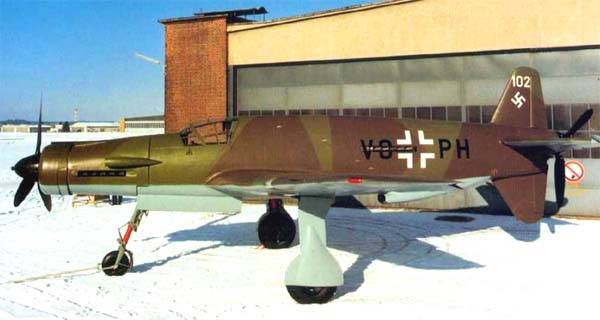
BUT at the end of the 1943 year, test flights began. All flights of the prototype were carried out by three experienced pilots: Altrogge, Quenzler and Dieterle.
During the fourth flight, the prototype developed a speed of 600 km / h at sea level. It turned out that the car is relatively uncomplicated in piloting, even with only one engine running. It was noted that on a propeller, the plane flies faster than on a propeller. On one screw, the aircraft reached speeds of up to 560 km / h.
There were many shortcomings, but this is basically normal for a new car. The rear engine warmed up strongly, the landing gear spontaneously folded. Moreover, this lack of landing gear was observed even in serial aircraft. The tail unit did not work very well, especially the elevator.
But the plane in general received very flattering reviews. Milch once again tried to convince Hitler, showing the results of tests in Rechlin, giving out additional motivation in the form of a bomb load (1000 kg for Do-335 versus 500 for Me.262) but all to no avail.
Unfortunately, the Fuhrer did not heed the arguments of Milch and the “Swallow” of Messerschmitt still had an unconditional priority. Dornier was comforted by permission to build another 14 aircraft. 12 serial Do-335A-1 and 2 two-seater training machines.
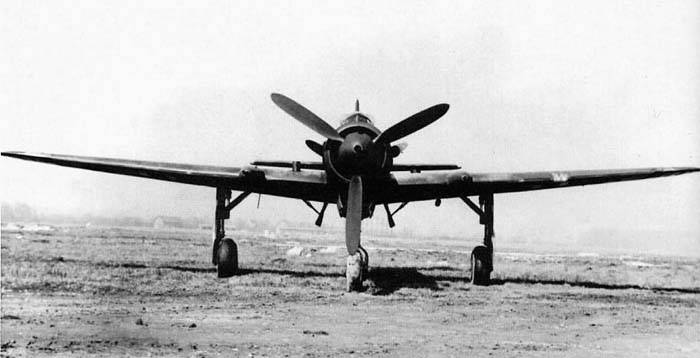
It was a complete fiasco, and all further work was carried out rather by inertia and in the expectation that Messerschmitt nevertheless screwed up with his “Swallow”.
Just slowly decided on weapons. Only the fifth specimen was armed, installing the MK.103 long-barreled cannon of the 30-mm caliber, firing through the front screw shaft and located in the collapse of the cylinder block. Two 20-mm MG-151 / 20 guns were installed above the motor. At the same time, the aircraft was able to take kg bombs into the 500 bomb bay.
And the tests continued in Rechlin. The tests involved one of the most experienced pilots in Germany, Heinrich Beauvais. During flights, he was able to repeatedly disperse the aircraft to 760 km / h. Only jet Me.262 and missile Me.163 flew faster. Taking into account all the exoticism of “Comet” Me.163, only Me-335 was the only competitor of Do-262.
Despite its impressive size, the Do-335 was surprisingly maneuverable. In test battles with Fw-190, Do-335 often mounted the Fokke-Wulf on the tail. And in an unfavorable situation, the pilot at Do-335 gave full throttle and instantly detached from the enemy. Not a single piston-powered aircraft, either German or Allied, could catch the “Arrow” Dornier. All this benefited the car.
The Do-335 cockpit was very comfortable, which was not often observed with German aircraft. From the Do-335 cockpit a good view was opened forward, to the side and down, since the cockpit was in front of the wings.
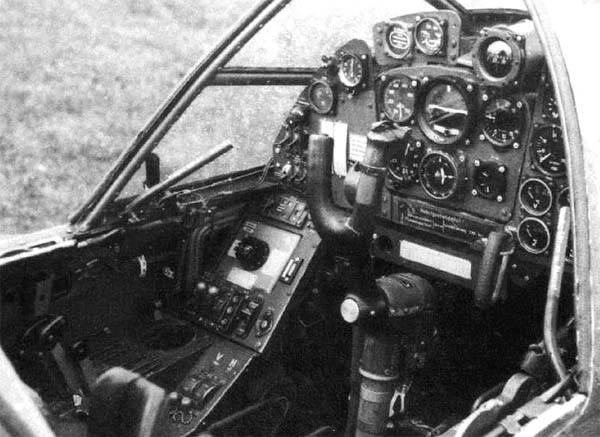
The back view was poor, the pilot saw only what the rear-view mirrors opened to him. Such mirrors were available on some prototypes, on individual A-0 aircraft and on production vehicles. That's only visible in them was not very much.
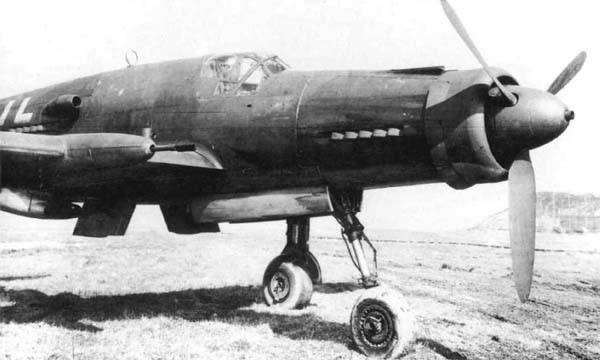
By the 1944 year, it became clear that the "Swallow" Messerschmitt "could not." Hitler decided to give priority to Do-335 and immediately begin its serial production. On July 7 of 1944, an official order followed ... But it was already too late.
The allies landed in Normandy, there was no way to stop them. The second front began to approach the borders of the Reich. What happened in the East, we all know very well from our history.
Do-335 and the Allies helped. And from the heart. On 28 on March 1944, 750 American bombers attacked the factories in Friedrichshafen and Oberpfaffenhofen, where Do-335 was assembled. However, the skillful actions of the air defense forces and the smoke screen delivered saved the plants. But during the summer, the Americans delivered several more blows, and on August 3, the Friedrichshafen factory was razed to the ground along with the pre-production Strel party.
Only in September 1944 did a special part of the Erprobungskommando 335 form, the task of which was to test the Do-335 in combat conditions. Several Do-335A-0 and, possibly, A-1 passed it. The task of the pilots of the unit was to develop tactics for using the aircraft as an interceptor, a sniper bomb and a scout. Captain Alfon Meyer became the squad leader.
26 October 1944 year in German air defense received a special order, which warned of the emergence of a new German aircraft. The order communicated the characteristic features of the machine: a cruciform tail and a tandem arrangement of engines.
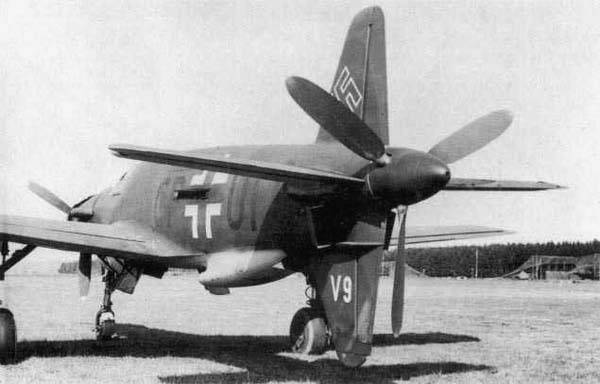
Aircraft from Erprobungskommando 335 did not often come into direct contact with the enemy. Only a few such cases have been noted. Confirmed the loss of one Do-335.
In total, before the end of the war, they managed to release the 61 Do-335 aircraft, counting all the prototypes. Some cars remained understaffed.
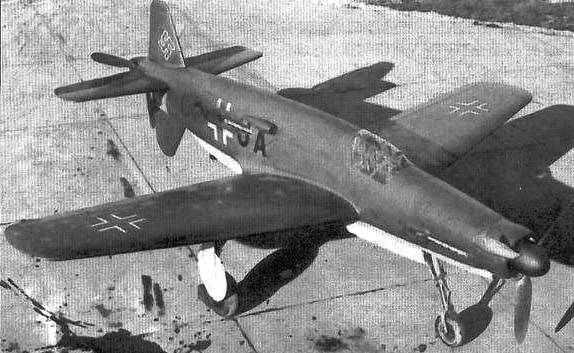
Nevertheless, even despite such modest successes, it was a very interesting aircraft with a very advanced design. Only jet aircraft could really compete with him.
Of course, even if, at the 1943 level of the year in Germany, they could arrange the production of this machine in sufficient quantities, it still would not solve the problem of the allies, who were crushing German cities in dust and rubble. To delay the end, to tighten the agony - is quite possible. But no more.
In order for Do-335 to have a real impact on the course of the war, and the plane could do it, because it was really good, and even more than that, it was necessary that they begin to be produced in large quantities at the turn of the 1942 of the year.
However, in the Reich they chose to drive thousands of very dubious Bf.109 and bet on Me.262.
In general, the story of Do-335 is the story that undercover games and intrigues for the sake of profits will not bring anyone to good. Which, in general, did not stop Willy Messerschmitt from dying as a respected person in Germany in 1978, after serving his post-war war.
Claudius Dornier died in 1969 at the age of 85 years in Switzerland. But if Dornier's flying boats are firmly in history as beautiful planes, then the Do-335 Strela has become a monument of a completely different kind.
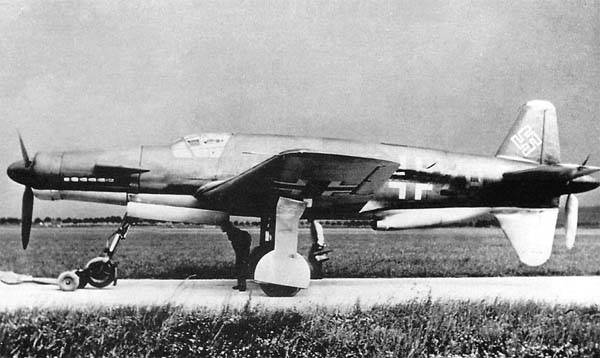
It is difficult to say, fortunately or unfortunately. This good plane could take more than one life of Soviet, American and English pilots, so it’s probably good that it happened.
LTX Do.335a-1
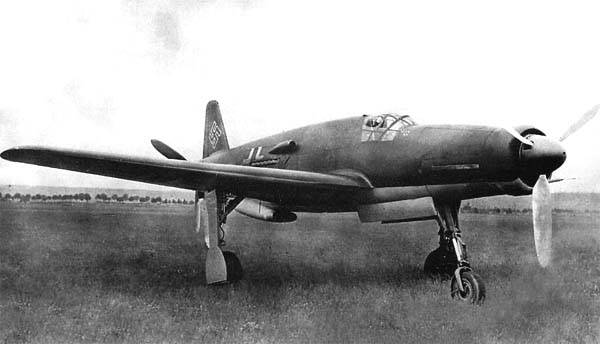
Wingspan, m: 13,80
Length, m: 13,83
Height, m: 5,00
Wing area, м2: 37,30
Weight, kg
- empty aircraft: 7 266
- takeoff: 9 600
Engine: 2 x Daimler-Benz DB 603Е-1 x 1800 (1900) hp
Maximum speed km / h: 785
Cruising speed, km / h: 682
Practical range, km: 1390
Maximum rate of climb, m / min: 1090
Practical ceiling, m: 11 400
Crew, prs: 1
Armament:
- one 30-mm gun MK-103 with 70 shells;
- Two 15-mm MG-151 guns with 200 cartridges per barrel;
- 1 x 500-kg bomb RS-500 or SD-500 or 2x 250-kg SC-250 in the bomb bay and 2 x 250-kg SC-250 on the outside.
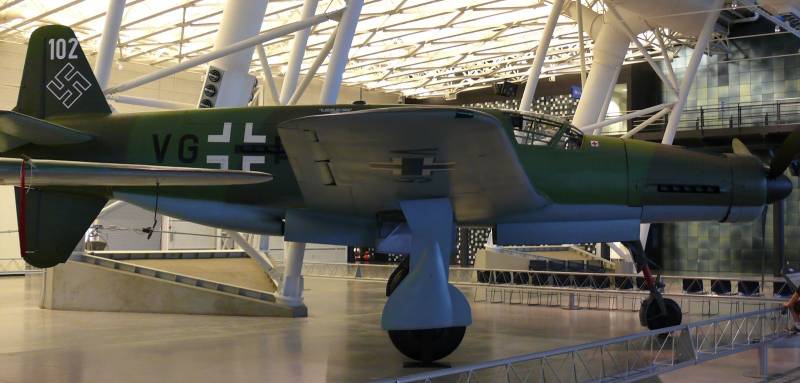
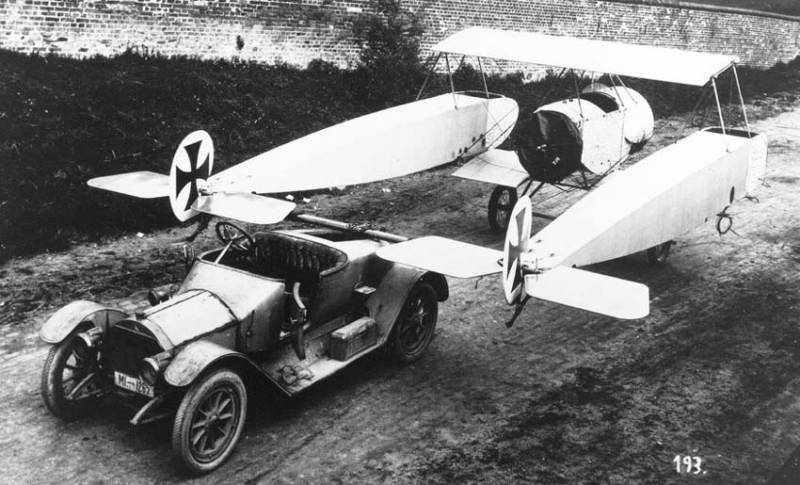
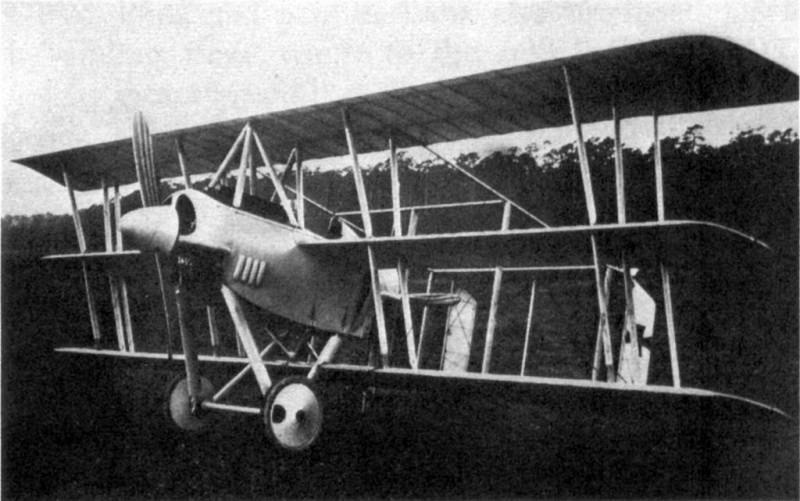
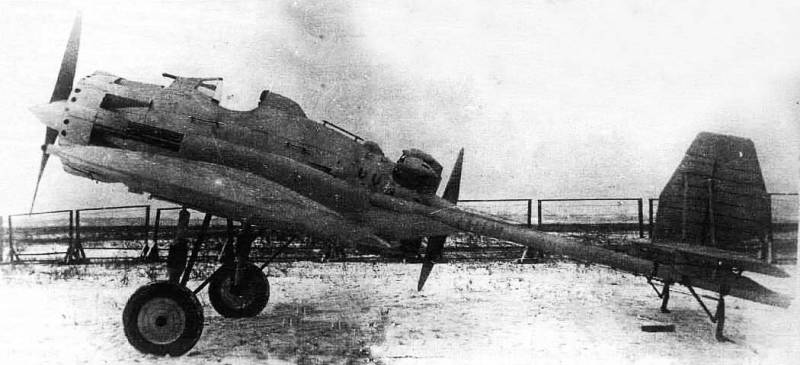
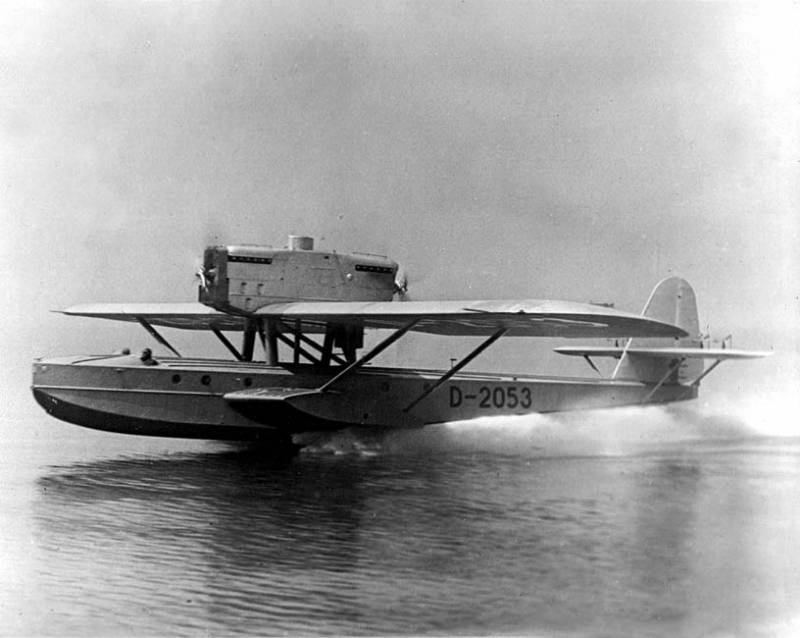
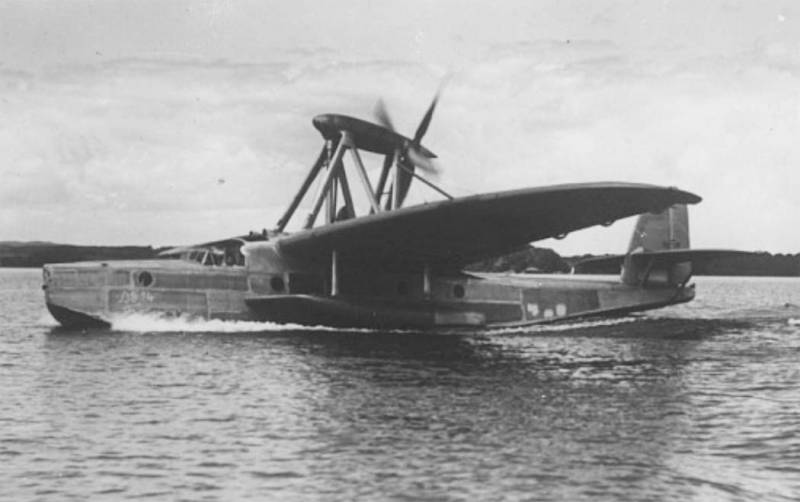
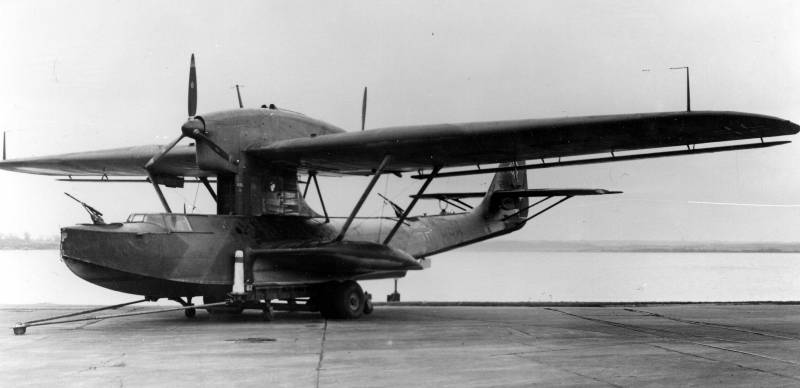
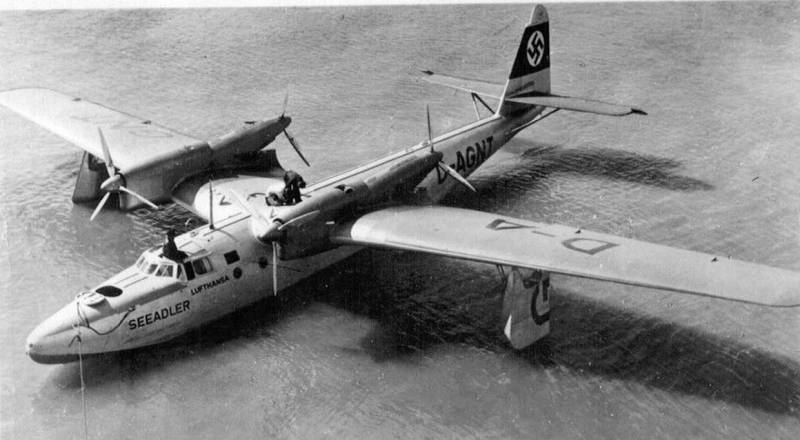
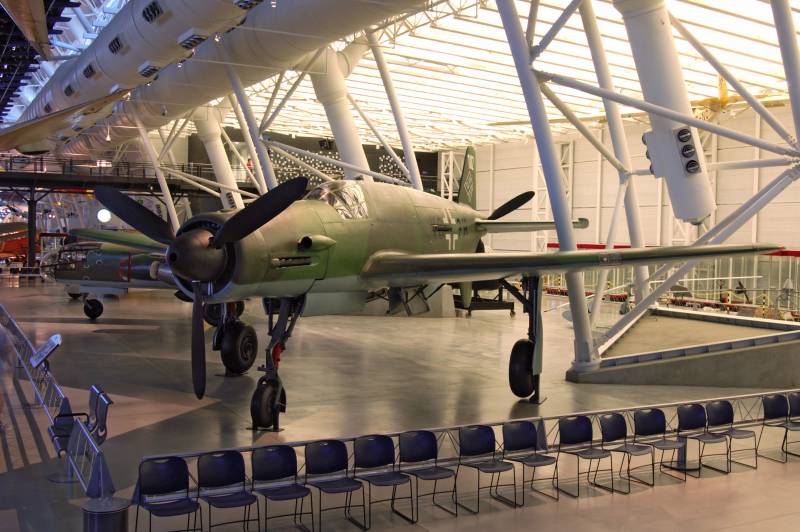
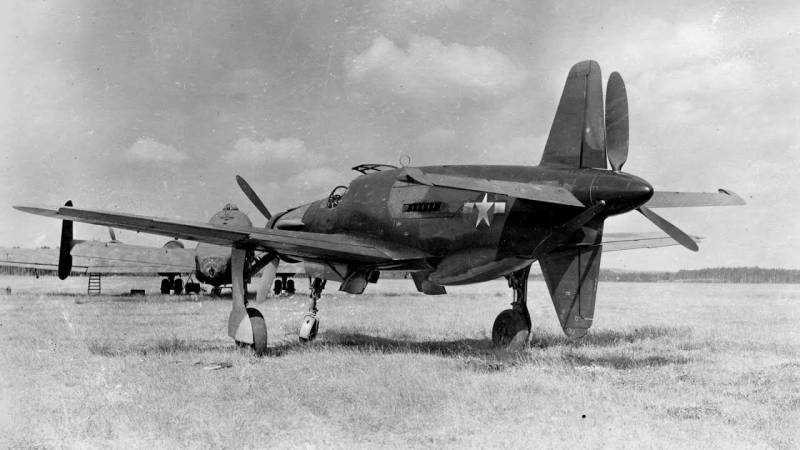
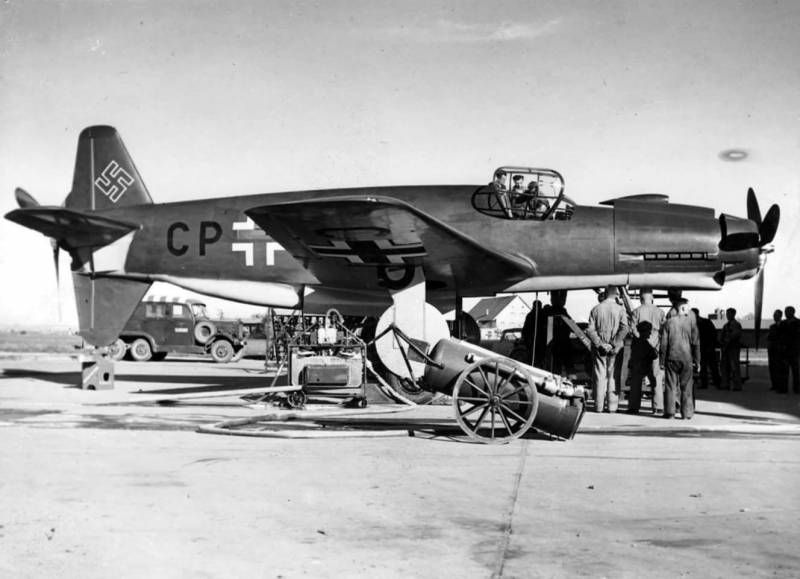
Information